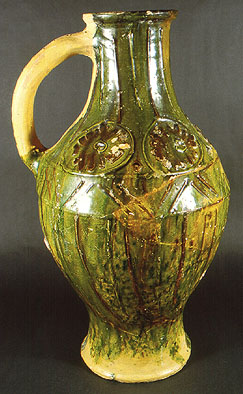| Fingerprints of the maker |
| Decorative techniques | |
| Surface treatment and decorative techniques can give insights into the quantity and quality of the workers engaged at a production centre in this labour-intensive craft. Decorative motifs may reflect the environment familiar to the potter, a family trademark or a reference to the intended use. They may also indicate social hierarchies, group identities or social status of the perceived consumer. Alternatively, their eye-catching appearance may have been designed to promote sales. Glazes in the medieval period were mainly lead-based, forming a yellowish-green vitreous surface. Mottled green and bright green colour was achieved by adding copper to the glaze. The craftsmen potters of the Brill/Boarstall production centre, strong market-leaders in the thirteenth century, showed great freedom of artistic expression. This suggests sound capital investment in a dynamic, well organised industry. |

The stimulus of this decorative jug may be derived from life in the forest where the potters gathered their fuel |
|
The making of the vessel |
Fingerprints ... |
How were pots fired? |
|
© Copyright University of Oxford, Ashmolean Museum, 2000 The Ashmolean Museum retains the copyright of all materials used here and in its Museum Web pages. last updated: jcm/27-jun-2000 |